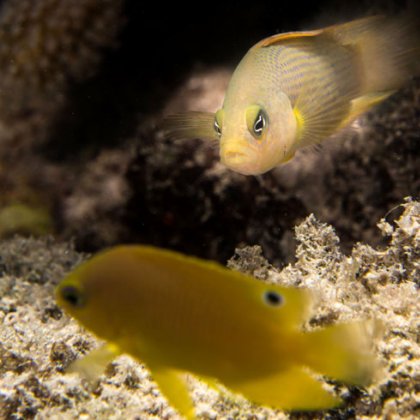
Treachery is afoot – or a-fin – on the Great Barrier Reef, where damselfish unknowingly harbour a masked killer in their midst.
An international team including University of Queensland researchers has found that, like the tale of a wolf in sheep’s clothing, damselfish are preyed upon by the dusky dottyback’s cunning mimicry.
UQ Queensland Brain Institute visiting scholar Dr Fabio Cortesi said the dusky dottyback changed colour to blend in with adult damselfish so it could prey on their young.
“We tested this wolf in sheep’s clothing predatory benefit by putting dottybacks with their regular prey – the juvenile damselfish,” Dr Cortesi said.
“We found that when dottybacks are the same colour as the damselfish parents, they’re up to three times as successful in feeding on the juveniles.
“The dusky dottyback and damselfish are similar in body shape and size, so this mimicry works really well, allowing them to mingle and sneak up on their prey.
“Smaller juvenile damselfish are the primary prey, but the adults don’t overly react to the dottybacks either. They are a master of disguise,” he said.
The research team was interested in finding out why some dusky dottybacks were yellow and some were brown.
“The team looked at whether they were a different species or population, but they’re actually identical genetically and simply have the ability to change colour between brown and yellow,” Dr Cortesi said.
“The change takes about two weeks, and is likely to occur when the dusky dottyback travels between feeding areas inside its territorial range.”
Researchers built artificial reefs with live coral and coral rubble and looked at whether the dusky dottybacks changed their colour based on the habitat or the colour of the fish that populate their natural habitat.
“If you put a brown dottyback with yellow damselfish, it’ll turn yellow over the course of about two weeks and vice versa,” Dr Cortesi said.
QBI’s Professor Justin Marshall said the team found the mimicry mechanism had another advantage for survival.
“By changing its colour to fit in with the local population of damselfish, the dusky dottyback blends into the habitat as a passive defence mechanism, so they don’t stand out to bigger predators,” Professor Marshall said.
The Queensland Brain Institute and UQ’s School of Biological Sciences collaborated with the University of Basel, the Australian National University, the University of Cambridge, James Cook University, the University of Saskatchewan, and theUniversity of Gothenburg.
Findings of the research, “Phenotypic plasticity confers multiple fitness benefits to a mimic”, are published in the journal Current Biology.
Media: UQ QBI Advancement and Communications Officer, Darius Koreis, +61 7 3346 6353, d.koreis@uq.edu.au; Professor Justin Marshall, +61 7 334 51397, justin.marshall@uq.edu.au.
Video available for media use on condition that 'Cell Press' is credited.
.jpg)


